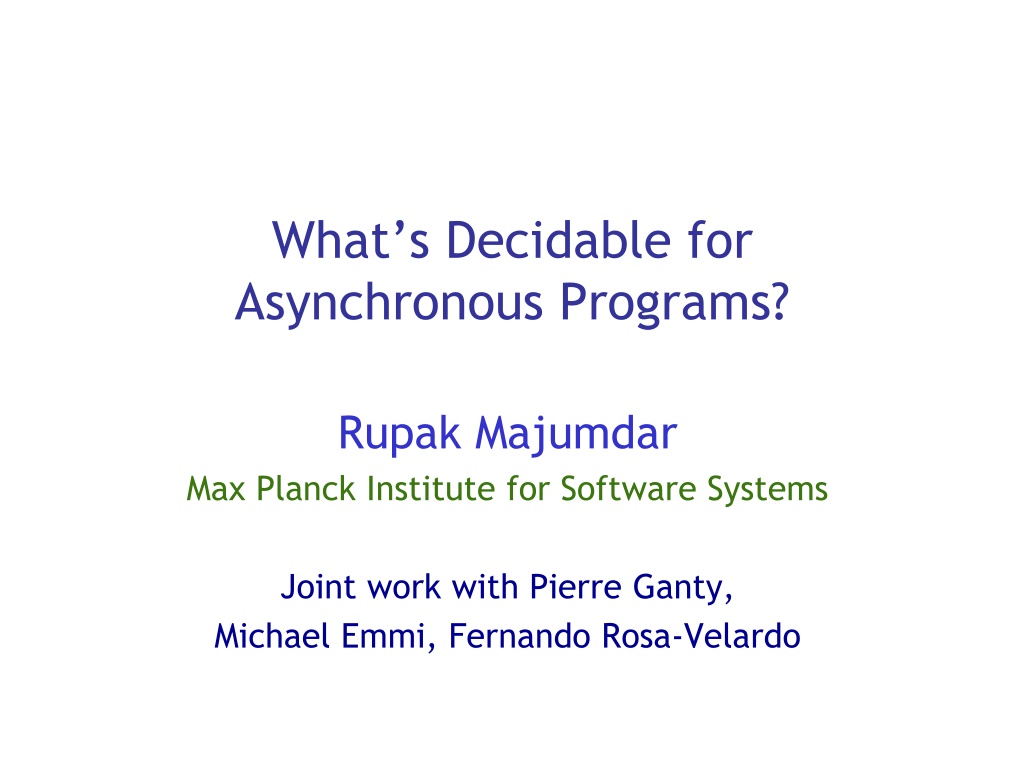
Decidability in Asynchronous Program Analysis
This talk by Rupak Majumdar explores the landscape of safety and liveness decidability in expressive classes of asynchronous programming models. It discusses the challenges of nontrivial decidability due to potentially unbounded stacks and buffers in asynchronous programs, emphasizing its importance as a basis for static analysis in correctness-critical settings. The session delves into the complexities of reasoning about code in asynchronous environments, showcasing the intricacies of program analysis in this context.
Download Presentation

Please find below an Image/Link to download the presentation.
The content on the website is provided AS IS for your information and personal use only. It may not be sold, licensed, or shared on other websites without obtaining consent from the author. If you encounter any issues during the download, it is possible that the publisher has removed the file from their server.
You are allowed to download the files provided on this website for personal or commercial use, subject to the condition that they are used lawfully. All files are the property of their respective owners.
The content on the website is provided AS IS for your information and personal use only. It may not be sold, licensed, or shared on other websites without obtaining consent from the author.
E N D
Presentation Transcript
Whats Decidable for Asynchronous Programs? Rupak Majumdar Max Planck Institute for Software Systems Joint work with Pierre Ganty, Michael Emmi, Fernando Rosa-Velardo
Asynchronous Programs Requests Responses Requests buffered and executed asynchronously Languages and Libraries: LibAsync, LibEvent, Go, Rust, Javascript/AJAX Android/iOS Programming Model: Distributed Systems Web Servers Embedded Systems Mobile platforms
Asynchronous Program Analysis This Talk: Decidability landscape of safety and (sometimes) liveness for expressive classes of asynchronous programming models [JhalaM07,GantyM.2012,EmmiGantyM.Rosa-Velardo15] Decidability is nontrivial: Not finite state or context free: - potentially unbounded stacks, - potentially unbounded request buffers, events Decidability is useful: basis for static analysis - Often used in correctness critical settings - The style breaks up control flow, making it difficult to reason about code
Simple Asynchronous Programs global bit b = 0; main(){ ... async h1(); ... } main ends in dispatch location Calls asynchronously posted functions h1(){ if(b == 0){ async h1(); async h2(); return; } Async calls stored in task buffer Scheduler picks a pending task and runs it to completion } h2(){ ... b = 1; ... return; }
Asynchronous Program Execution global bit b = 0; PC main(){ ... async h1(); ... } Execution starts in main Task buffer empty h1(){ if(b == 0){ async h1(); async h2(); return; } Pending Calls h1 } h2(){ ... b = 1; ... return; } State: b = 0
Asynchronous Program Execution global bit b = 0; main(){ ... async h1(); ... } Execution enters dispatch loop Picks pending call and executes it Returns to dispatch loop on return PC h1(){ if(b == 0){ async h1(); async h2(); return; } PC Pending Calls h1 h1 h2 } h2(){ ... b = 1; ... return; } State: b = 0
Asynchronous Program Execution global bit b = 0; main(){ ... async h1(); ... } Pick another pending call PC h1(){ if(b == 0){ async h1(); async h2(); return; } PC Pending Calls h1 h2 h1 h2 } h2(){ ... b = 1; ... return; } State: b = 0
Asynchronous Program Execution global bit b = 0; main(){ ... async h1(); ... } Pick some pending task PC h1(){ if(b == 0){ async h1(); async h2(); return; } Pending Calls h2 h1 } h2 h2(){ ... b = 1; ... return; } PC State: b = 0 State: b = 1
Asynchronous Program Execution global bit b = 0; main(){ ... async h1(); ... } Pick some pending task PC PC h1(){ if(b == 0){ async h1(); async h2(); return; } Pending Calls h2 h1 } h2(){ ... b = 1; ... return; } State: b = 1
Asynchronous Program Execution global bit b = 0; main(){ ... async h1(); ... } And the program terminates PC h1(){ if(b == 0){ async h1(); async h2(); return; } Pending Calls h2 } h2(){ ... b = 1; ... return; } PC State: b = 1
Properties: Safety global bit b = 0; Given a Boolean asynchronous program and a control location in a handler main(){ ... async h1(); ... } Is there an execution which reaches the control location? h1(){ if(b == 0){ async h1(); async h2(); return; } We do not care about the task buffer - Handlers cannot take decisions based on the contents of the task buffer } h2(){ ... b = 1; ... return; }
Properties: Termination global bit b = 0; Given a Boolean asynchronous program, Does it terminate? main(){ ... async h1(); ... } h1(){ if(b == 0){ async h1(); async h2(); return; } main does not terminate on all runs What if h1 is chosen over h2 forever? } h2(){ ... b = 1; ... return; }
Fairness global bit b = 0; main(){ ... async h1(); ... } An infinite execution is fair if - For every handler h that is pending - The scheduler eventually picks and runs an instance of h h1(){ if(b == 0){ async h1(); async h2(); return; } - So: the run choosing h1 over h2 always is not fair } - Will focus on fair runs - Captures the intuition that scheduling is fair h2(){ ... b = 1; ... return; }
Fair Termination Given: A simple asynchronous program with Boolean variables Check: There is no fair infinite run LTL model checking for pushdown systems [Walukiewicz, BouajjaniEsparzaMaler, Steffen] Two checks: (a) Each called handler terminates (b) There is no infinite fair execution of handlers
Petri Nets Can convert an asynchronous program into a Petri net in polynomial time s.t. every execution of the async program is equivalent to an execution of the PN In particular: The asynchronous program is safe iff the Petri net is coverable The asynchronous program fairly terminates iff the Petri net has no fair infinite runs
General Scheme for the PN Task buffer: One place for each handler Posts add a token to the place for the handler Scheduler Dispatch takes a token from the scheduler and one from the buffer (nondet) Places for global state Task completion puts token back on scheduler Petri net representation for the CFG of each handler
Removing the Stack Observation: Just the number of async calls matter, not the order in which they are made Parikh s Lemma: For every context free language L, there is a regular language L such that: For every w in L, there is a permutation of w in L and conversely So: can replace a recursive handler with a non- recursive one while maintaining the summary
Polynomial Time Conversion Do not explicitly compute the Parikh image (that FSA can be exponentially bigger) Instead, go from the CFG for a handler to a Petri net: Places: Terminals + Non-terminals Transitions: A -> BC takes a token from A and puts a token each in B and C
Example: CFG PN Problem: How do you know the grammar has a full derivation? There are no tokens in the variable places S Theorem [EsparzaKieferLuttenberger, EsparzaGantyKieferLuttenberger] For a CFG with n nonterminals, the 2n- index language has the same Parikh image A a b So give a budget to the PN
Petrification global bit b = 0; pending pending h1 h2 dispatch main(){ ... async h1(); ... } set b:=1 b=0 b!=0 h1(){ if(b == 0){ async h1(); async h2(); return; } Code for h1 } Tokens: Control flow in each handler Pending handler calls h2(){ ... b = 1; ... return; }
Safety Verification Theorem: Safety verification EXPSPACE- complete Simple async program Petri net Coverability Poly time
Fair Termination Theorem: Fair termination for simple async programs is decidable and equivalent to PN reachability Program PN Yen s logic to encode fair termination No implementation yet
An Aside on Implementation Two approaches to verification: 1. Abstract the program, use generic PN coverability tool bfc, mist, iic [KaiserKroeningWahl,Ganty,KloosM.NiksicPiskac] 2. Directly perform analysis on the program [JhalaM.07], using counter abstractions and expand-enlarge-check [GeeraertsRaskinvanBegin] Some initial progress, but no stable source-level tools Also, tools for bug finding [EmmiLalQadeer,MaiyaKanadeM.]
A Related Result Theorem: [BozzelliGanty] Backward iteration terminates in doubly exponential many iterations on PN [M.Wang14] EEC terminates in at most doubly exponential many iterations - With space efficient implementations of reachability, EEC is in EXPSPACE
Real Asynchronous Programs Cancel tasks Dynamically create task buffers Associate events with tasks, wait and synchronize on events Dynamically create events
Real Asynchronous Programming Programmers create events dynamically Tasks wait in task buffers and are activated by events One or more threads execute tasks from buffers (often, threads are associated with a buffer)
Example global bit b = 0; event e; main(){ e = new event async p1 {} buf; async p2 {e} buf; } p1(){ b = 1; sync e } p2(){ assert (b==1); }
Canceling tasks cancel h remove all pending occurrences of h Safety remains decidable Go to PN + reset Liveness is undecidable
Dynamic Buffers buf = new buffer post handler buffer Safety remains decidable: - hierarchical PN: Buffer tokens carry their own multiset of pending handlers - depth bounded pi-calculus [Meyer] - direct wqo construction
Events Problem: Tasks can pend on several events, and they are released by the first event that occurs There can be unbounded chains created by tasks waiting on event sets Do not see how to encode in depth bounded pi-calculus
Petri Data Nets Tokens carry data from dense linearly ordered domain - Places, transitions as for PN - Transition of arity n has a precondition sequence of length n and a postcondition sequence of length n: - how many tokens of the ith identity are consumed, how many are produced
Example a x c x<y<z z b
Modeling Pending Events I Tokens carry one identity, but tasks can wait on multiple events Attempt 1: Guess which token will fire the task at task creation Does not work what if event 1 always happens before event 2? Add spurious behaviors
Modeling Pending Events II Use the linear ordering! Guess the order in which events will fire at event creation time At task creation time, select the minimal event it pends on Plus some bookkeeping to ensure ordering of events is maintained Details are complicated
Safety Verification Theorem: [EmmiGantyM.Rosa-Velardo] Safety verification decidable (but Ackermann hard) Async program Petri data net Coverability [LazicNewcombOuaknineRoscoeWorrell] Poly time
Summary Asynchronous programs are a common programming idiom High performance Complicated code Good static analysis tools can help We now have the theoretical foundations Decidable safety, decidable liveness under abstraction But still some ways from scalable tools In particular, tools that work on source code
Questions? http://www.mpi-sws.org/~rupak/

